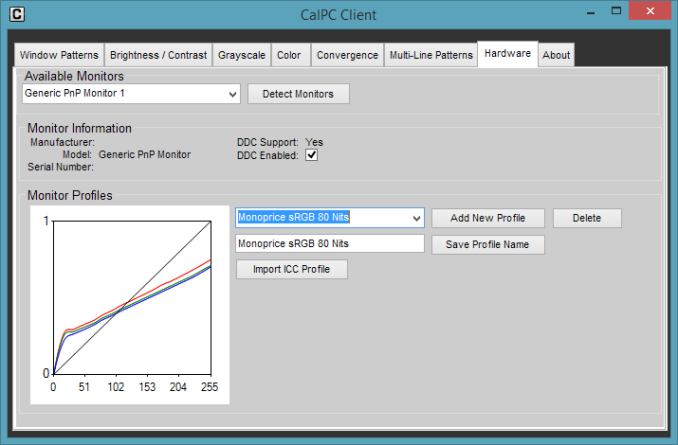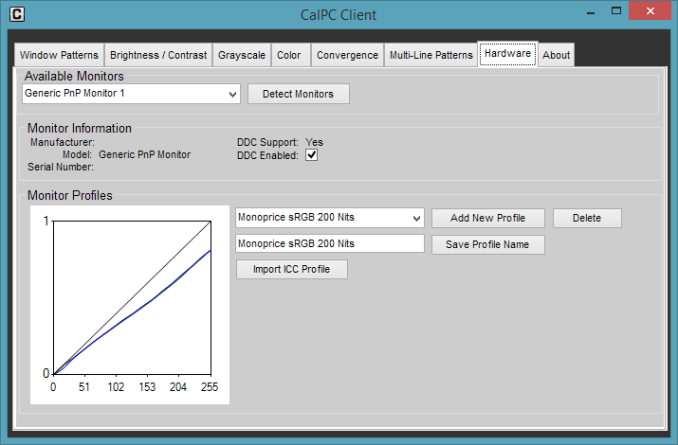Monoprice Zero-G Slim 27" IPS Monitor Review
by Chris Heinonen on August 26, 2013 12:00 AM ESTAll calibrations are done using CalMAN 5.1.2 software with an i1Pro meter and a C6 meter. Our targets are 200 cd/m^2 and gamma 2.2 for the pre-calibration and post-calibration measurements with the sRGB colorspace. We also try for 80 cd/m^2 and the sRGB gamma curve to see how well a display handles a more demanding professional setting.
| Pre-Calibration |
Post-Calibration, 200 cd/m^2 |
Post-Calibration, 80 cd/m^2 |
|
|---|---|---|---|
| White Level (cd/m^2) | 325.75 | 199.38 | 81.14 |
| Black Level (cd/m^2) | 0.373 | 0.335 | 0.322 |
| Contrast Ratio | 874:1 | 595:1 | 252:1 |
| Gamma (Average) | 1.309 | 2.195 | 3.051 |
| Color Temperature | 6744K | 6584K | 6648K |
| Grayscale dE2000 | 7.853 | 0.589 | 1.100 |
| Color Checker dE2000 | 7.611 | 0.942 | 1.000 |
| Saturations dE2000 | 5.413 | 1.083 | 0.995 |
Running the Zero-G at Contrast 50 and Brightness 50 with the sRGB preset, these are the best numbers I could obtain without a calibration. Since we are targeting 200 cd/m^2 and not 325 cd/m^2, that makes the numbers worse since we are expecting it to be 200 cd/m^2.
We see the gamma is incorrect and there are large grayscale errors. If I adjust the Brightness to 0 we see a gamma that is still wrong, and a blue color shift that gives us an average color temp of 8797K. The contrast ratio also falls to 580:1 and overall performance is worse.
If you only look at the Color Gamut chart, everything looks nice. Switch to the Saturations chart and you’ll see that the 40% red saturation target is past even where 60% should be. Blue and Magenta are over-saturated as well. The color checker chart confirms these saturation errors. This is why using only the standard gamut chart, as many people and print magazines do, provides little insight into actual performance.
Out of the box, the Monoprice Zero-G offers weird, strange performance that I haven’t seen in a long time. It also offers proof of why a panel in a monitor is only a small part of what leads to a quality display.
Calibrate the Monoprice and you have a totally different display. Look at the numbers and they are virtually perfect. If you are targeting 200 cd/m^2 you will have trouble doing better except with contrast ratio and black level. Those are still worse than what other monitors can produce.
Calibrate for 80 cd/m^2 and an sRGB target and you’ll see that performance isn’t quite as good as the 200 cd/m^2 target. The reason is the brightness control. Below are images from the CalPC client that CalMAN uses to calibrate. You can see the default line (in black) and the adjustments made to Red, Green and Blue channels for different output levels. Ideally these should track the default line.
On the Monoprice they start out much lower on the right. Because we have to correct for the brightness levels in the LUT, instead of using the display controls, we lose dynamic range and contrast ratio. The black level doesn’t change but the white level is dropping. We also don’t have as much room for adjustment for the gamma curve, which is why the sRGB one suffers.
CalMAN has corrected a lot of the flaws in the Monoprice compared to the default settings, but it has to take a large hit to contrast ratio to do so.






























79 Comments
View All Comments
Ammaross - Monday, August 26, 2013 - link
http://www.tomshardware.com/reviews/aoc-q2963pm-ul...There. :)
cheinonen - Monday, August 26, 2013 - link
I always find this funny, since Chris Eberle (who writes the display reviews for Tom's Hardware) and I both handle all the projector and flat panel reviews at Secrets of Home Theater (hometheaterhifi.com).mfenn - Monday, August 26, 2013 - link
Wait a minute. You're saying that it's OK to wait for the Monoprice monitor to go on sale, but not OK to wait for the Dell? How much sense does that make?steven75 - Monday, August 26, 2013 - link
The review seems to conclude that this is a case of getting what you pay for. I agree with that conclusion based on the test results.boozed - Monday, August 26, 2013 - link
"this article is disappointing."I've always been disappointed by honest reportage too.
JlHADJOE - Monday, August 26, 2013 - link
He's probably looking for some affirmation on his recent purchase. I, for one am happy with the honest reporting. Always better to know more about a product before buying it.If i'm going to spend extra over a TN monitor to get IPS because better colors and viewing angles, then it might as well be an IPS that actually gives better colors.
psuedonymous - Monday, August 26, 2013 - link
TFTCentral reviewed the Acheiva Shimian 27" IPS Zero-G (which the Monoprice is a rebrand of), and explained that the weird brightness/contrast issue is due to the backlight being lit at a constant level, and brightness just changing the digital brightness (i.e. lowering brightness lowers dynamic range, raising it too far results in clipping). See: http://www.tftcentral.co.uk/reviews/achieva_27_ips...DanNeely - Monday, August 26, 2013 - link
More interesting is that Acheiva told TFTCentral that they will be replacing the current brightness adjustment with a PWM one. Presumably that means the monoprice model will also be updated.cheinonen - Tuesday, August 27, 2013 - link
I wasn't told that by Monoprice. My impression is that an update isn't forthcoming as it isn't something they have control over.blackoctagon - Tuesday, August 27, 2013 - link
How confident are you that 'this' Monoprice is a rebrand of 'that' Shimian? That Shimian review is very specific about the A-IPS panel from LG used, but neither this AT review nor the Monoprice website specify the panel used in this monitor. We don't even know what subtype of IPS this is, AFAIK.